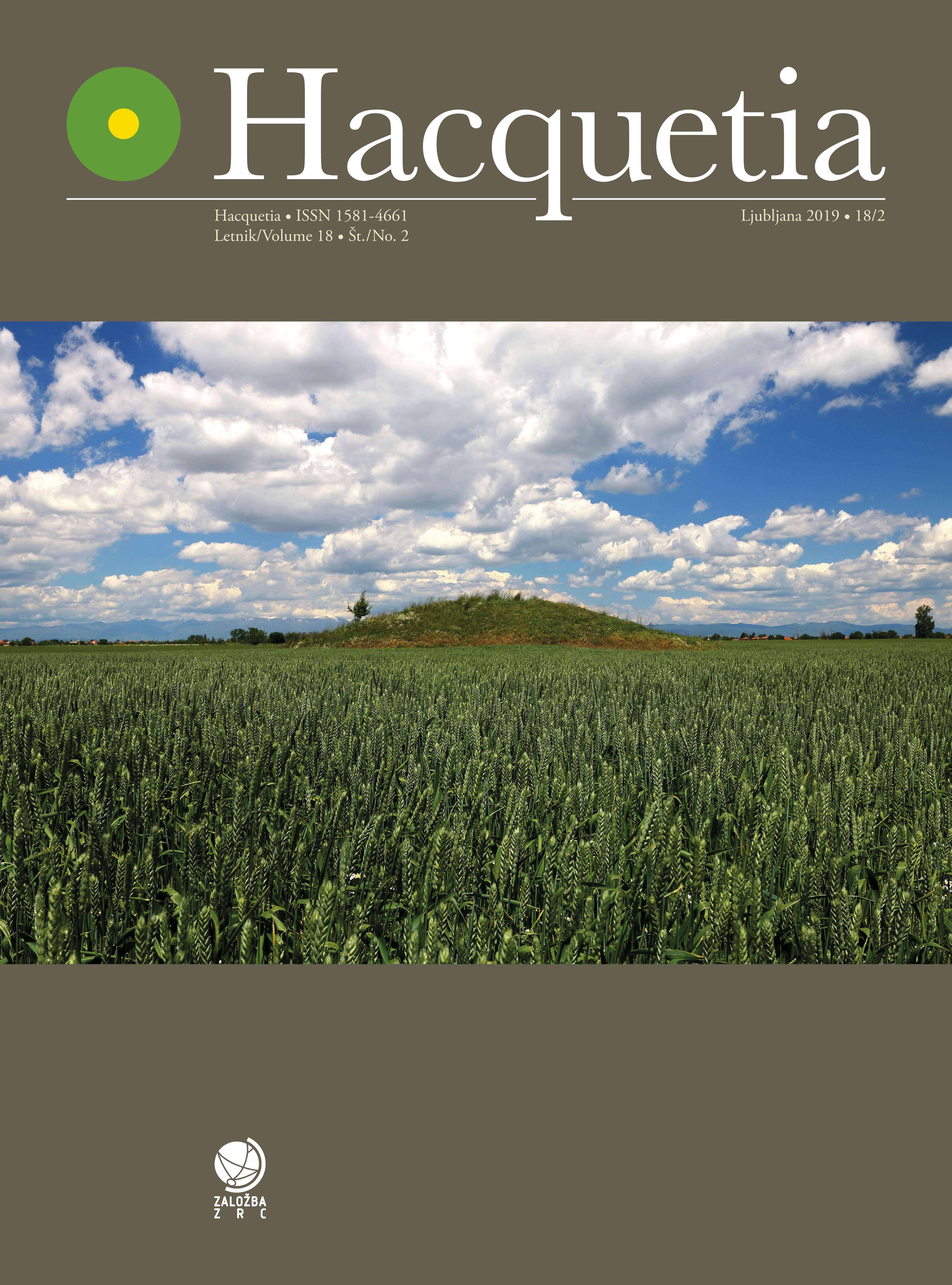Species delimitation and inter-specific gene flow in Tamarix L. (Tamaricaceae)
DOI:
https://doi.org/10.2478/hacq-2019-0001%20Keywords:
Tamarix, ITS, HGT tree, Species delimitationAbstract
Tamarix L. play important role in preventing deforestation in Iran. Tamarix species exhibit wide range of morphological variation therefore, the species delimitation become difficult. This is further complicated due to similarity of morphological characters in closely related species and the occurrence of interspecific hybridization. The present study was performed to identify Tamarix species and their potential hybrids in Semnan Province of Iran. We used ITS and ISSR and 42 morphological characters for our investigation. Molecular phylogeny of the studied species and their relationship was not in agreement with the species tree of morphological characters and with taxonomic treatment of the genus. HGT tree of ITS and morphological data obtained revealed the occurrence of inter-specific hybridization or introgression between Tamarix species.
Downloads
References
Arianmanesh, R., Mehregan, I., Nejadsatari, T. & Assadi, M. 2015:
Molecular phylogeny of Tamarix (Tamaricaceae) species from Iran
based on ITS sequence data. European Journal of Experimental
Biology 5: 44–50.
Baldwin, B. G., Sanderson, M. J., Porter, J. M., Wojciechowski,
M. F., Campbell, C. S. & Donoghue, M. J. 1995: The ITS region of
nuclear ribosomal DNA-A valuable source of evidence on Angiosperm
phylogeny. Annals of the Missouri Botanical Garden 82: 247–277.
Baum, B. R. 1967: Introduced and naturalized tamarisks in the United
States and Canada [Tamaricaceae]. Baileya 15: 19–25.
Baum, B. R. 1978: The Genus Tamarix. Jerusalem, Israel: Israel
Academy of Sciences and Humanities.
Bredenkamp, C. & Phepho, N. 2008: Hybridization of Tamarix
usneoides and Tamarix ramosissima. Unpublished. South African
Botanical Institute.
Enninful, E. K. &Torvi, D. A. 2008: A variable property heat transfer
model for predicting soil temperature profiles during simulated
wildland fire conditions. International Journal of Wildland Fire 17:
–213.
Brotherson, J. D. & Winkel, V. 1986: Habitat relationships of
saltcedar (Tamarix ramosissima). The Great Basin Natural 46: 535–541.
Campbell, J. Y., Lo, A. & Mackinlay, A. C. 1997: The Econometrics of
Financial Markets Princeton University Press, Princeton, N.J.
Gaskin, J. F. 2003: Tamaricaceae. In: Kubitzki, K & Bayer, C.
(eds.). The Families and Genera of Vascular Plants. Springer. pp.
‒368.
Gaskin, J. F. & Kazmer, D.J. 2009: Introgression between invasive
saltcedars (Tamarix chinensis and T. ramosissima) in the USA. Biological
Invasions 11: 1121–1130.
Gaskin, J. F. & Schaal, B. A. 2002: Hybrid Tamarix widespread in
U.S. invasion and undetected in native Asian range. Proceedings of
the National Academy of Sciences of the United States of America 99: 11256–11259
Gaskin, J. F. & Schaal, B.A. 2003: Molecular Phylogenetic
Investigation of U. S. Invasive Tamarix. Systematic Botany 28: 86–95.
Hammer, Ø., Harper, D. & Ryan, P. D. 2012: PAST: Paleontological
Statistics software package for education and data analysis.
Palaeontologia Electronica 4: 1–9.
Heywood, V. H., Brummitt, R. K., Culham, A. & Seberg, O. 2007:
Flowering Plant Families of the World. Kew: Royal Botanic Gardens.
Ijbari, H., Sheidai, M., Mehrabian, A. R., Noormohammadi, Z. &
Ghasemzadeh-Baraki, S. 2014: K-means clustering and STRUCTURE
analyses of genetic diversity in Tamarix L. accessions. Turkish journal
of botany 38: 1080–1094.Križman, M., Jakše, J., Baričević, D., Javornik, B. & Prosek, M., 2006:
Robust CTAB activated charcoal protocol for plant DNA extraction.
Acta agriculturae Slovenica 87: 427–433.
Le Roux, J. & Wieczorek, A.M. 2008: Molecular systematic
and population genetics of biological invasions: towards a better
understanding of invasive species management. Annals of Applied
Biology 157: 1–17.
Mayonde, S. G., Cron, G. V., Gaskin, J. F. & Byrne, M. J. 2015:
Evidence of Tamarix hybrids in South Africa, as inferred by nuclear
ITS and plastid trnS–trnG DNA sequences. South African Journal of
Botany 96: 122–131.
Mayonde, S. G., Cron, G. V., Gaskin, J. F. & Byrne, M. J. 2016:
Tamarix (Tamaricaceae) hybrids: the dominant invasive genotype in
southern Africa. Biological Invasions 18: 3575–3594.
Mayonde, S, Cron, G.V, Glennon, K. L & Byrne, M. J. 2019: Genetic
diversity assessment of Tamarix in South Africa – Biocontrol and
conservation implications. South African Journal of Botany 121:
–62.
Obermeyer, A. A. 1976: Tamaricaceae. In: Ross, J.H. (ed.): Flora
of southern Africa. Botanical Research Institute, Department of
agricultural technical services, Pretoria.
Podani, J. 2000. Introduction to the Exploration of Multivariate Data.
Backhuyes, Leiden, 407 pp.
Schaal, B. A., Gaskin, F. & Caicedo, A. L. 2003: Phylogeography,
haplotype trees, and invasive plants. Journal Heredity 94: 197–204.
Rieseberg, L. H., Raymond, O., Rosenthal, D. M., Lai, Z.,
Livingstone, K., Nakazato, T., Durphy, J. L., Schwarzbach, A. E.,
Donovan, L. A. & Lexer, C. 2003: Major ecological transitions in wild
sunflowers facilitated by hybridization. Science 301: 1211–121.
Schierenbeck, K. A. & Ellstrand, N. C. 2009: Hybridization and the
evolution of invasiveness in plants and other organisms. Biological
Invasions 11: 1093–1105.
Schiman-Czeika, H. 1964: Flora Iranica. Graz: Akademische Druck-u.
Verlagsanstalt, Vol. 4.
Sheidai, M., Zanganeh, S., Haji-Ramezanali, R., Nouroozi, M.,
Noormohammadi, Z. & Ghsemzadeh-Baraki, S. 2013: Genetic
diversity and population structure in four Cirsium (Asteraceae) species.
Biologia 68: 384−397.
Sheidai, M., Ziaee, S., Farahani, F., Talebi, S.M., Noormohammadi, Z.
& Hasheminejad Ahangarani Farahani, Y. 2014: Infra-specific genetic
and morphological diversity in Linum album (Linaceae). Biologia 69:
–39.
Sudbrock, A. 1993: Tamarisk control-fighting back: an overview of
the invasion, and a low-impact way of fighting it. Restoration and
Management. Notes 11: 31–34.
Tamura, K., Peterson, D., Peterson, N., Stecher, G., Nei, M., Kumar,
S. 2012: MEGA5: molecular evolutionary genetics analysis using
maximum likelihood, evolutionary distance, and maximum parsimony
Downloads
Published
How to Cite
Issue
Section
License
Copyright (c) 2019 ZRC-SAZU

This work is licensed under a Creative Commons Attribution-NonCommercial-NoDerivatives 4.0 International License.
Authors guarantee that the work is their own original creation and does not infringe any statutory or common-law copyright or any proprietary right of any third party. In case of claims by third parties, authors commit their self to defend the interests of the publisher, and shall cover any potential costs.
More in: Submission chapter













